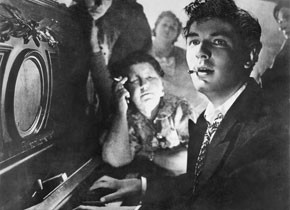The Cinema of the Thaw
Filmmaking in the Soviet Union, 1957-67
March 8 to April 11, 2012
The “thaw period” of Soviet cinema is a key era of international film history – in fact, only one other era may be considered equally relevant: New Hollywood.
Ottepel, meaning thaw, is the title of a story published in 1954 by Ilya Ehrenburg. The story's appearance was taken as a sign of changes to come in Soviet policy, as Ehrenburg's USSR had little in common with the country known through the officially published works of the previous two decades. Thaw was the first widely received reckoning with Stalinism – a signal moment. Not long thereafter, Nikita Khrushchev's so-called secret speech at the XX Congress of the CPSU in February 1956 made it clear that the USSR would seriously undertake a kind of fresh start. Thus began a period of rebuilding and upheaval, which shortly thereafter was named after Ehrenburg's literary-political watershed work.
Strictly speaking, only a relatively short phase of the Soviet Union's history is considered as the “Thaw” – the mid-nineteen fifties. Colloquially, however, the term is used today to describe the approximately one and a half decades between Stalin's death in 1953 and that moment in 1967/68 where the ultraconservatives under Leonid Brezhnev gained complete control over the state and suffocated the last breaths of liberalism – at least until the late 1980s, the era of perestroika and glasnost.
In cinema, the Thaw was not just the emergence of a new generation. On the contrary: shortly before the death of Stalin, a grim war veteran film by the “old master” Vsevolod Pudovkin had already predicted the climatic changes that were on the way, pointing towards a historical peculiarity of thaw era cinema: never before or since have different generations worked together to effect a fundamental renewal of their filmmaking – not even in the multi-generational cinema of New Hollywood.
The key figures and designers of the Thaw Generation include: 1. Mikhail Romm (Nine Days in One Year, Ordinary Facism), Mikhail Kalatozov (The Cranes are Flying, The Unsent Letter) and Fridrikh Ermler (Before the Verdict of History) – three established masters who had all debuted in the silent era; 2. Marlen Khutsiyev (Zastava Il'iča / I Am Twenty), Grigory Chukhrai (Ballad of a Soldier), Aleksandr Alov & Vladimir Naumov (Pavel Korčagin), Mikhail Shveitser (Time, Forward!) and Vladimir Vengerov (Workers’ Quarters) – all war veterans who, at the time of the German invasion in 1941, had either just finished or were just about to start their filmmaking studies, and who were given very few chances for many years after 1945; 3. Andrey Tarkovsky (Ivan's Childhood, Andrei Rublev), Larisa Shepitko (Wings) and Andrei Konchalovsky (The Story of Asya Klyachina) – who, as teenagers survived the war and became students and protégés of the second generation.
While today it is primarily the younger generation that is remembered, it was the older filmmakers whose political skill and artistic genius made the thaw possible in the first place: the king of the kolkhoz musicals, Ivan Pyryev, who, in just a few years as director of Mosfilm created a relatively free space where the younger filmmakers could experiment; Mikhail Romm, who taught at the VGIK film school and from there launched his protégés; Fridrikh Ermler and Iosif Kheifits who, while at Lenfilm, developed the idea – along the lines of Ehrenburg – that realism could make progress visible to a skeptical yet hopeful people: gray on gray, full of crackling heroes and unfulfilled longing. And Mikhail Kalatozov, in his collaborations with Sergei Urusevsky – perhaps the greatest cinematographer of all time – became the pioneer of a new, visually breathtaking narrative style. It often bordered on pure abstraction and influenced a long line of followers, including Terrence Malick. The younger group of thaw filmmakers followed seamlessly behind, although their works often featured a joy and serenity that was alien to the older generation. It is worth noting that the veterans were more interested in a realistic narrative, whereas the younger ones were more drawn to formal compression and abstraction.
Things soon became unpleasant for the leaders of this movement. Although the Thaw is less a “history of victims” than once might at first think, time and again it still came down to smaller and larger problems, which usually meant: films were recut, and sometimes even had to be partially re-filmed. The most notable example was Marlen Khutsiyev’s central work, I Am Twenty,a monument to his forsaken but never forgotten generation. 1966, however, marked the beginning of a period of official repression: Alov and Naumov’s dark Dostoevsky adaptation, Ugly Anecdote, lingered quietly on the shelf, without any official censorship (the movie was conveniently “forgotten”), but the following year brought a hailstorm of bans. It was the fiftieth anniversary of the October Revolution – and Soviet cinema never would never recover from these ravages inflicted by the state.
This retrospective, curated by Olaf Möller, is the first comprehensive project on the Cinema of the Thaw in Austria. It was organized in cooperation with Gosfilmofond, the Federal Ministry for European and International Affairs in Austria and the Austrian Cultural Forum in Moscow.


